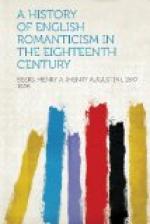In 1740 Joseph Warton, then an Oxford undergraduate, wrote his blank-verse poem “The Enthusiast, or the Lover of Nature.” The work of a boy of eighteen, it had that instinct of the future, of the set of the literary current, not uncommon in youthful artists, of which Chatterton’s precocious verses are a remarkable instance. Composed only ten years later than the completed “Seasons,” and five years before Shenstone began to lay out his miniature wilderness at the Leasowes, it is more distinctly modern and romantic in its preference of wild nature to cultivated landscape, and of the literature of fancy to the literature of reasons.
“What are the lays of
artful Addison,
Coldly correct, to Shakspere’s
warblings wild?”
asks the young enthusiast, in Milton’s own phrase. And again
“Can Kent design like
Nature?. . .
Though he, by rules unfettered,
boldly scorns
Formality and method, round
and square
Disdaining, plans irregularly
great?. . .
“Versailles
May boast a thousand fountains
that can cast
The tortured waters to the
distant heavens;
Yet let me choose some pine-topped
precipice
Abrupt and shaggy, whence
a foamy stream,
Like Anio, tumbling roars;
or some black heath
Where straggling stands the
mournful juniper,
Or yew tree scathed.”
The enthusiast haunts “dark forests” and loves to listen to “hollow winds and ever-beating waves” and “sea-mew’s clang.” Milton appears at every turn, not only in single epithets like “Lydian airs,” “the level brine,” “low-thoughted cares,” “the light fantastic dance,” but in the entire spirit, imagery, and diction of the poem. A few lines illustrate this better than any description.
“Ye green-robed Dryads,
oft at dusky eve
By wondering shepherds seen;
to forest brown,
To unfrequented meads and
pathless wilds
Lead me from gardens decked
with art’s vain pomp. . .
But let me never fall in cloudless
night,
When silent Cynthia in her
silver car
Through the blue concave slides,.
. .
To seek some level mead, and
there invoke
Old midnight’s sister,
contemplation sage
(Queen of the rugged brow
and stern-fixed eye),
To lift my soul above this
little earth,
This folly-fettered world:
to purge my ears,
That I may hear the rolling
planet’s song
And tuneful turning spheres.”




